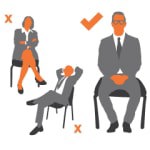
Saying the right thing in an interview is only part of the equation for success. Based on Psychologist Albert Mehrabian’s research, your gestures, handshake, eye contact, facial expressions and body posture make up 55% of the impression you leave when meeting another person. The tone and speed of your voice add another 35%. That leaves only 7% for what you actually say to make a difference. This means that even if you’re giving outstanding answers, you won’t come across as credible or confident if your body language doesn’t back it up, which will seriously harm your chances. The non-verbal cues that you give off are just as important as anything you can say out loud. Here’s how to ensure you’re prepared for more than just the questions.
Look the person you’re meeting in the eye and find the sweet spot between too soft and too aggressive with your grip. If you’re unsure, spend some time practising. This may sound a little crazy, but a handshake ‘bookends’ your interview, so it’s important to get it right.
Make eye contact but don’t maintain it for too long. Eye contact is crucial as it shows you are prepared to answer questions and you’re not trying to be evasive. However, overdoing it by staring deeply into someone’s eyes for an extended period can make you come across poorly in a variety of ways; from disengaged to plain creepy! Instead, try “direct face contact” and move your eyes around the interviewer's face for a more toned-down approach.

Complement the words you’re saying with hand gestures. If your hands are by your side the whole time, you’ll come across as anxious or distrustful. When you do let your hands-free, ensure you avoid pointing or other aggressive movements!

Don’t lean back or cross your arms, this is a sign that you’re disinterested, or worse, untrustworthy. However, leaning in when you say something important is a great way to add extra gravitas.

Fidgeting is a tell-tale sign that you are anxious or you have had too much coffee! Stay cool, calm and collected and keep your caffeine and sugar intake to a minimum.
On your way to the interview room, make sure you’re following or walking alongside the interviewer, not leading them!

Not crossing your legs and keeping your feet planted on the ground will help you to stop fidgeting and stay calm. It can also help you to answer more complex questions, as your brain can switch from creative to rational thought more quickly.

The principles of body language that apply to you as an interviewee are equally applicable to an interviewer. It’s therefore advisable to also consider the body language of your interviewer. This will give you a good indication of what they’re looking for and allow you to adjust your body language to suit. For example, you may notice that you’re speaking with a dominant character/personality who welcomes longer eye contact, or that you need to lower your voice because the person sitting opposite to you is more introverted.
Body language is a complex topic. Being aware of your physical movements and also taking into consideration the tell-tale signs of your interviewer will help you to excel in your next job interview.
If you enjoyed reading this article, don’t forget to follow us on LinkedIn for all our latest articles.
For more important interview tips and how to prepare, please have a look at: